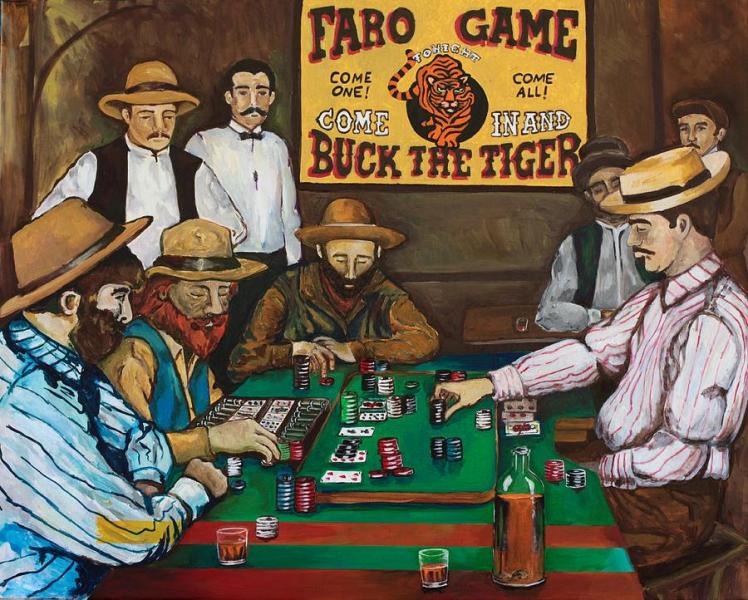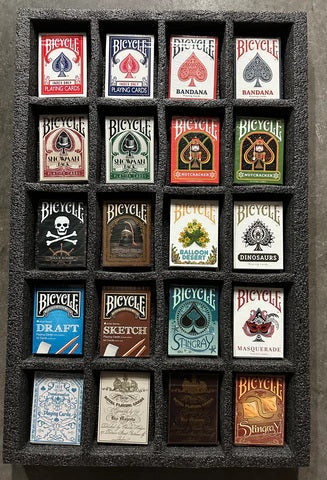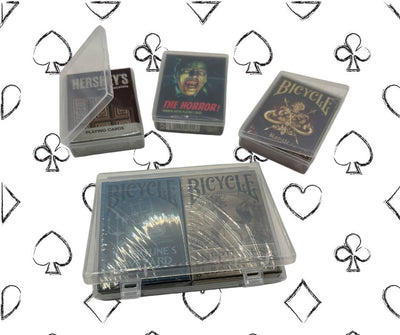by BoardGameGeek reviewer EndersGame
When you start immersing yourself into the world of playing cards, you'll soon discover that it has its own language. Before you know it, you'll be using terms that don't even exist in the average person's vocabulary! You'll find yourself talking about various cards sleights and flourishes, and the finer details of crowdfunded decks, which are purchased in "bricks", and can include "interior printing" and "embossing" courtesy of "overfunding" and "stretch goals." Fans, spreads, and shuffles are relatively easy to understand, but do you know the difference between a riffle shuffle, hindu shuffle, overhand shuffle ... and a faro shuffle?
Ah, the faro shuffle. I've always been fascinated by this technically difficult move, which involves making the halves of a deck interweave perfectly. But it's not just the name of a shuffle, because it is also the name of a popular gambling game from the 1800s. Where does this name originate from, and are there more "faro" related terms in the world of playing cards? Let's find out!
The Faro Shuffle
Of the faros that we'll meet in today's article, the faro shuffle is probably the most well-known today, so let's start there. The faro shuffle is the most common way of referring to it, although in some places it is also called the weave shuffle or the dove-tail shuffle. It's a very impressive move, and it can be combined very naturally with some other flourishes like a waterfall or a cascade for a dramatic visual display.The faro shuffle involves splitting the deck into exactly two equal halves of 26 cards each, and then interweaving them perfectly so that the cards from each packet alternate exactly, coming together much like a zipper. The new order of the cards after a perfect faro shuffle should always turn out exactly the same each time you do it, but this does depend on where you start the weave, and there are two different methods for this. An out-shuffle keeps the top card and bottom card in those positions, while an in-shuffle moves the top and bottom card to second from the top and bottom respectively. An interesting fact about the faro shuffle is that eight perfect out-shuffles using the faro will restore the deck to its original order exactly. You need to be a skilled card handler to do this, because you only need one tiny mistake and it won't work! Meanwhile doing 26 consecutive perfect in-shuffles will reverse the order of a complete deck, which is even harder to do without error!
Let me warn you: the faro shuffle is not an easy thing to learn! The hardest part is where the cards get weaved together, which requires pushing the cards against each other with a small amount of pressure and at just the right angle, causing them to interweave smoothly just like a zipper. It's one of those "knacky" things, that all of a sudden you'll just master, much like learning to ride a bike. Riding with training wheels can help, but in the end, you just need to launch off and hope for the best. And perhaps you'll wipe out a bunch of times, but then all of a sudden you'll figure out the knack of keeping your balance, and off you go, and you'll never look back. For many people, that's what learning the faro shuffle can be like, and that's certainly how it was for me. There are a few decent tutorials online, and I've included some links to a number of these below, including the free one by Howcast. I watched a few tutorials online, and the one I personally found the most helpful turned out to be the paid tutorial from The Virts, which included instructions for how to do the beautiful cascade as an immediate follow-up to the faro shuffle.
The type of deck you are using can also make a difference as to the ease or difficulty of doing a faro shuffle. A new deck tends to work best, while a very worn or cheap deck will often be very difficult to faro smoothly. The direction in which the cards weave together also is important, because this depends on the "cut" of the deck. This in turn is a result of how the cards were punched, which creates a tiny bevel on the edge of the cards, and the direction of this bevel will affect the direction of how the cards can be best faroed. Most Bicycle decks have a modern cut, which will faro best face down, whereas a deck with a traditional cut will faro best face up.
The Faro Game
The game of Faro does bear some connection with the faro shuffle, the relationship being this: when a game of faro ends ends there are two equal piles that have to be combined for the next game. The method of interweaving the cards perfectly as described above was traditionally used for combining these piles, and one source says that it was originally called the "faro dealer's shuffle". If true, it means that the faro shuffle originated with the game, and only later came to be associated with card magic as we know it today. So what is this card game about?As it turns out, Faro is a casino gambling game that originated in France in the late 17th century, and was a derivative of the gambling card game Basset (also known as Bassetta in Italian), also known as Barbacole and Hocca. The name was apparently first Pharaon, and was likely a reference to the Pharaoh picture on some French playing cards. It's not too difficult to surmise how this title later became Pharo, and eventually turned into Faro.
During the 18th century the card game of Faro was very popular in Europe. Faro was mentioned multiple times by 18th century Italian adventurer and writer Casanova in his autobiography. It also received mention in many important films, plays and novels, including Tolstoy's War and Peace. It eventually made its way to the United States, and was commonly played during the Gold Rush era, although by this time it had largely disappeared already from Europe. When gambling became legalized, Faro enjoyed great popularity in American casinos, with some even describing it as "the national card game". It appears to have been the main attraction at many gambling houses.
Faro did go out of style by the 1950s, eventually being overtaken by Poker, so it's not at all very well known today. But during its hey-day in the wild west, it was one of the most played games in the country. So if you found a group of cowboys playing a card game in a saloon, there was a good chance they would be playing Faro. It was reportedly the favourite card game of well-known 19th century names like lawman Wyatt Earp and gambler Doc Holiday. Travellers in Nevada can still visit the famous "Suicide Table" upon approaching Virginia City, which is an old faro table from the 1860s that is now a tourist attraction. This legendary table apparently led to the death of three of its owners by suicide, including "Black Jake", who gambled away his lifelong savings of $70,000 in a single evening.
So how do you play? I won't describe all the rules in detail, but you can find them in some archived websites here and here. Only one deck of cards was used, and the key moment of a game was when the banker turned up cards to match cards that were already face-up. Often called "faro bank", one player served as the banker. A standardized betting layout corresponded to the 13 values of an entire suit, and other players would bet on these values using money or chips.
The dealer would always turn up two cards at a time, and the first card turned up represented a loss for that value, while the second card always won. Players were effectively betting whether a card would lose or win, although there were some special rules and situations. Bets would be paid and collected immediately, before dealing another two cards. Losing cards would form one pile, and winning cards another - these would then be shuffled for the already mentioned "faro dealer's shuffle" at the end of a game.
Cheating was common, often leading to fights, and occasionally weapons were even pulled out and used. But there is also a non-gambling variant of Faro, called Stuss.
Other Faros
Are there other card-related Faros? I was able to find a few more, and perhaps there are others that readers can tell us about.The Faro Playing Card Company attempted to crowdfund three custom decks in 2013, but judging by the Kickstarter pages for these projects, these didn't end very happily for the majority of customers.
Much more positive things can be said about the Faro deck which was crowdfunded by noted designer Stockholm17, and released this year. This stunning deck is a companion to his Cartomancer deck, and together these two decks make up the House of the Rising Spade set. The Faro deck is inspired by old gambling decks from the 1800s, and features cards with a one-way design and no indices, and of course fully customized artwork in Stockholm17's inimitable and classy style. Indices were a development that occurred at a later date, so at the time when the game of faro was popular, cards would typically have been indexless just like this particular deck is.
Also worth mentioning are the Faro Playing Cards from the Parnell Playing Card Company, which specializes in authentic faro playing cards and games from the Wild West. Besides selling felt faro layouts (which come with game rules), they also make available a faro deck, each packaged with a picture of a legend like Wyatt Earp. Like the House of the Rising Spade deck, these cards do not have any indices, and are intended to look like the cards from the Wild West era in which the game of Faro was popularized.
Also check out the new Bicycle Faro Edition playing cards produced by PCD.

Do you want to try the game of Faro, or are you perhaps looking for a vintage deck of playing cards that looks as if it hails from the Wild West era? Consider picking up the House of the Rising Spade Faro deck, or check out the other Vintage decks that PlayingCardDecks has on offer.
Do you want to learn how to do the faro shuffle? Besides the instructional video from Howcast, there are plenty of other good tutorials teaching this difficult shuffle, including ones from Chris Ramsay, 52Kards, Cardistry Academy, Hester23BearsCH, Ekaterina, School of Cardistry, and lotusinhand. Don't give up too easily - it's well worth the effort required to master this classic and rewarding shuffle!
About the writer: EndersGame is a well-known and highly respected reviewer of board games and playing cards. He loves card games, card magic, cardistry, and card collecting, and has reviewed several hundred boardgames and hundreds of different decks of playing cards. You can see a complete list of his game reviews here, and his playing card reviews here. He is considered an authority on playing cards and has written extensively about their design, history, and function, and has many contacts within the playing card and board game industries. You can view his previous articles about playing cards here. In his spare time he also volunteers with local youth to teach them the art of cardistry and card magic.





